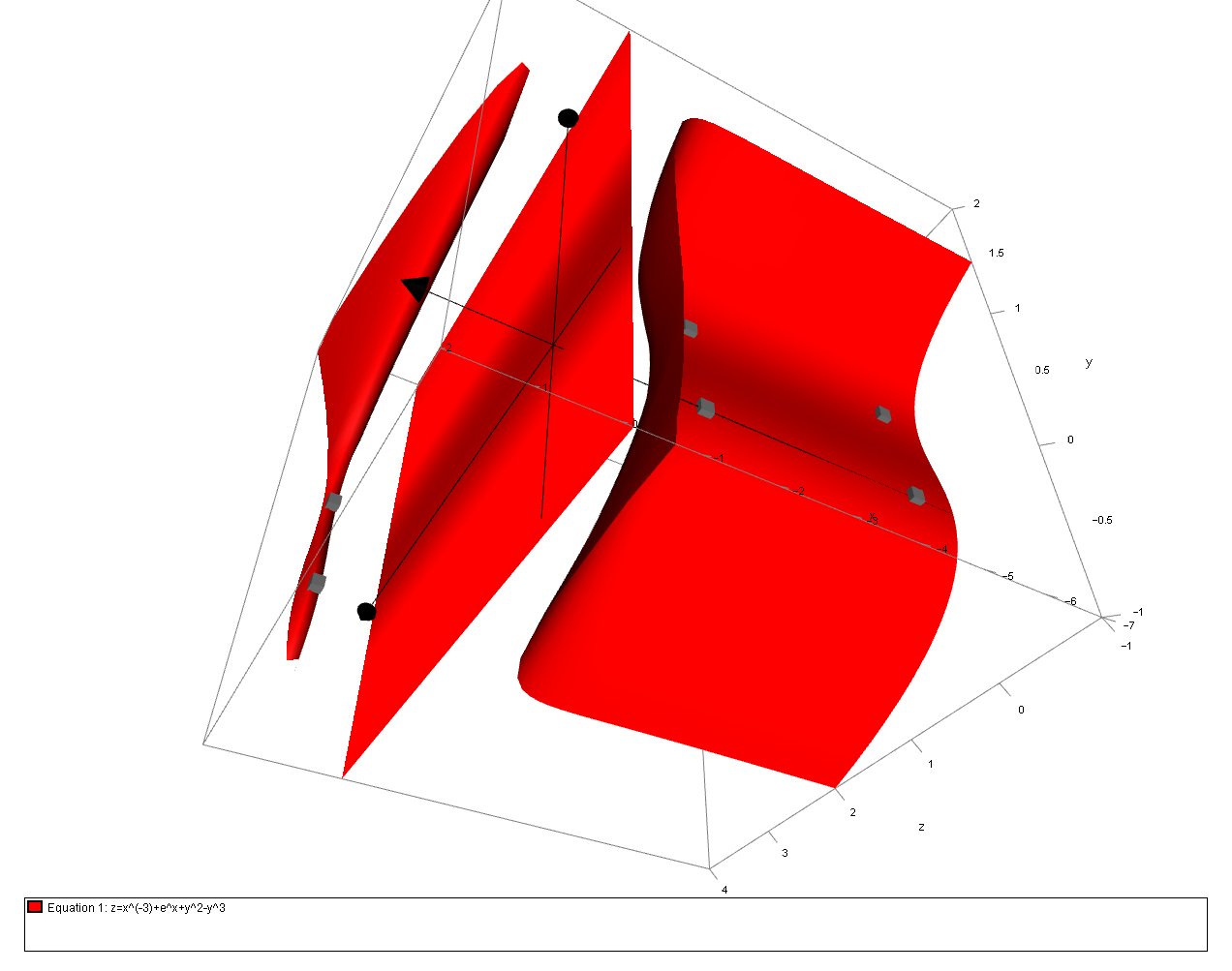What are the values and types of the critical points, if any, of #f(x,y) =x^-3 + e^x+y^2 - y^3#?
1 Answer
# {: ("Critical Point","Type"), ((-6.199,0,-0.002),"maximum"), ((-2.395,0,0.018),"saddle"), ((1.020,0,3.716),"maximum"), ((-6.199,2/3,0.146),"saddle"), ((-2.395,2/3,0.167),"minimum"), ((1.020,2/3,3.864),"saddle") :} #
Explanation:
The theory to identify the extrema of
- Solve simultaneously the critical equations
# (partial f) / (partial x) =(partial f) / (partial y) =0 \ \ \ # (ie# f_x=f_y=0 # ) - Evaluate
#f_(x x), f_(yy) and f_(xy) (=f_(yx))# at each of these critical points. Hence evaluate#Delta=f_(x x)f_(yy)-f_(xy)^2# at each of these points - Determine the nature of the extrema;
# {: (Delta>0, "There is maximum if " f_(x x)<0),(, "and a minimum if " f_(x x)>0), (Delta<0, "there is a saddle point"), (Delta=0, "Further analysis is necessary") :} #
So we have:
# f(x,y) = x^(-3) + e^x + y^2 - y^3 #
Let us find the first partial derivatives:
# (partial f) / (partial x) = -3x^(-4)+e^x#
# (partial f) / (partial y) = 2y-3y^2 #
So our critical equations are:
# e^x - 3/x^4 = 0 # ..... [1]
# 2y-3y^2 = 0 # ..... [2]
From the these equations we have:
For [1] Using Newton Rhapson (to 4dp):
# x=-6.1988, -2.3951, 1.0199 # For [2]:
#2y-3y^2 = 0 => y(2-3y)=0 #
# y=0,2/3 #
Any permutation of these solutions will simultaneously make both partial derivatives vanish, so the critical values are:
# (x,y) = (-6.199, 0), (-2.395, 0), (1.020, 0,) #
# " " = (-6.199, 2/3), (-2.395, 2/3), (1.020, 2/3) #
So we can now calculate the coordinates of the critical points:
# {: (f(-6.199,0),= -0.002,=>(-6.199,0,-0.002)), (f(-2.395,0),= 0.018,=>(-2.395,0,0.018)), (f(1.020,0),= 3.716,=>(1.020,0,3.716)), (f(-6.199,2/3),= 0.146,=>(-6.199,2/3,0.146)), (f(-2.395,2/3),= 0.167,=>(-2.395,2/3,0.167)), (f(1.020,2/3), = 3.864,=>(1.020,2/3,3.864)) :} #
We can visualise these critical points on a 3D-plot:

So, now let us look at the second partial derivatives so that we can determine the nature of the critical point (I'll just quote these results):
# \ \ \ (partial^2f) / (partial x^2) = e^x-12x^(-5) #
# \ \ \ (partial^2f) / (partial y^2) = 2-6y #
# (partial^2f) / (partial x partial y) = 0 \ \ \ \ (=(partial^2f) / (partial y partial x))#
And we must calculate:
#Delta=(partial^2f) / (partial x^2) (partial^2f) / (partial y^2) - ((partial^2f) / (partial x partial y))^2 #
at each critical point. The second partial derivative values,
# {: ("Critical Point",(partial^2f) / (partial x^2),(partial^2f) / (partial y^2),(partial^2f) / (partial x partial y),Delta,"Conclusion"), ((-6.199,0,-0.002),0.001,2,0,>0,"maximum"), ((-2.395,0,0.018),-0.061,2,0,<0,"saddle"), ((1.020,0,3.716),13.647,2,0,>0,"maximum"), ((-6.199,2/3,0.146),0.001,-2,0,<0,"saddle"), ((-2.395,2/3,0.167),-0.061,-2,0,>0,"minimum"), ((1.020,2/3,3.864),13.647,-2,0,<0,"saddle") :} #

